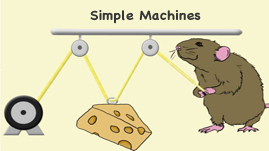Teachers' Domain - Digital Media for the Classroom and Professional Development
User: Preview


KET's Everyday Science is funded in part by Kentucky Power and the American Electric Power Foundation and PNC Bank.
Machines make life easier—and sometimes more fun. A simple machine has few moving parts. In this KET interactive children can begin to explore the basic operations of three simple machines.
This resource is part of the KET Everyday Science collection.
Machines make life easier—and sometimes more fun. Children can be encouraged to explore how wheels help cars, grocery carts, and doll buggies move. Springs, such as those found in clothes pins, can hang clothes on a clothesline, make sitting on the couch more comfortable, and add some fun to a pogo stick.
Pulleys, levers, and gears are a few examples of simple machines, mechanical devices that enhance our ability to move and manipulate objects. Because they have few moving parts, simple machines are a good tool for introducing more complicated concepts like design and function to very young children.
A pulley is made of a wheel with a rope that fits on the groove of the wheel. One end of the rope is attached to the load—the other end of the rope allows you to move the load up. Samples of pulleys include cranes (with a wrecking ball or one that lifts construction materials), clotheslines, and flag poles
A lever is a rigid object - often a flat bar - that moves against a fixed point called a fulcrum. One example of a lever is a see saw like the one that may be on your playground. Levers help us lift heavy loads while using less energy.
Gears are actually a special type of lever. Gears are round discs with spokes that fit in the spokes of other gears. When one gear moves, the spokes connect and the other gear moves. Gears are used in many other machines.
As with all science activities, close supervision is required as children explore how machines work, but everyday life offers many opportunities for children to observe simple machines and learn how they help people perform tasks and have fun.
The Teaching Tips will give you some ideas how to continue the conversation and expand on the content in the interactive.
Vocabulary
wheel, motion, axle, force
 Loading Standards
Loading Standards Teachers' Domain is proud to be a Pathways portal to the National Science Digital Library.
Teachers' Domain is proud to be a Pathways portal to the National Science Digital Library.
